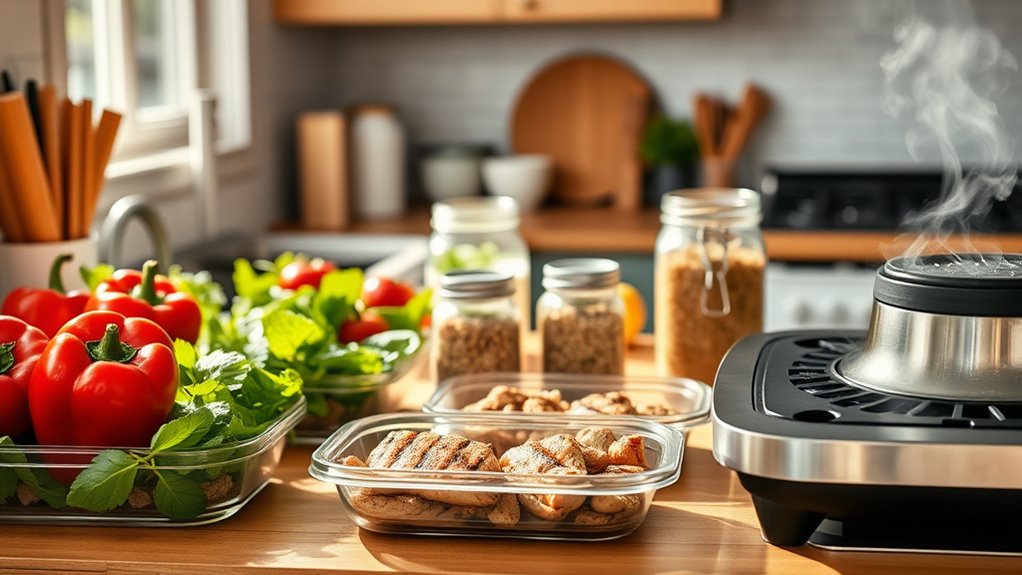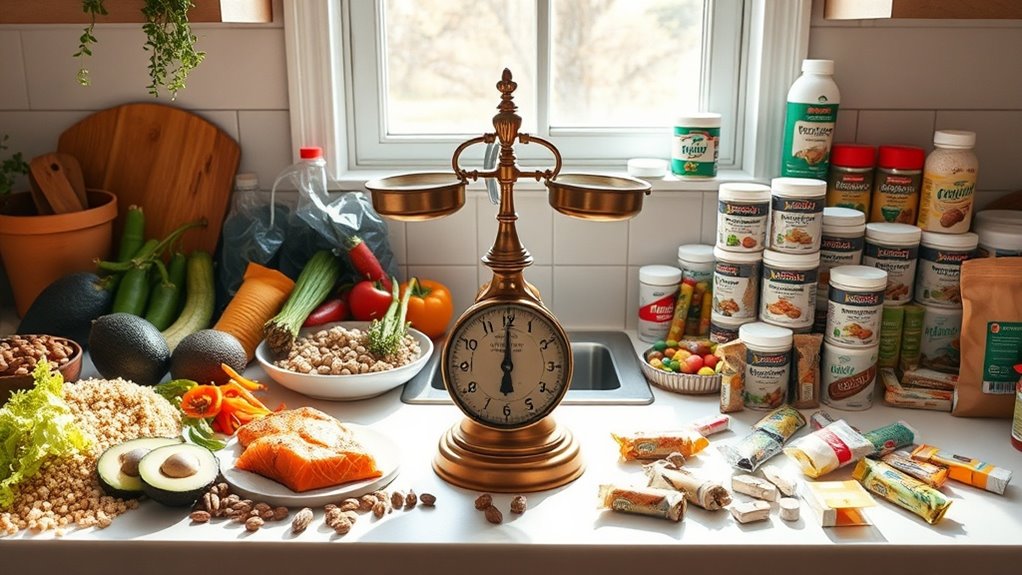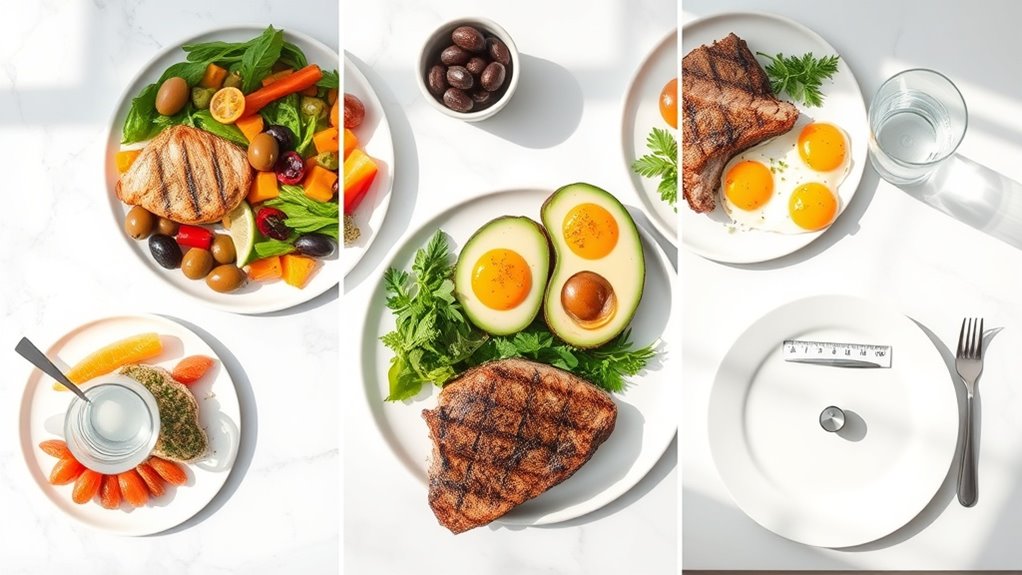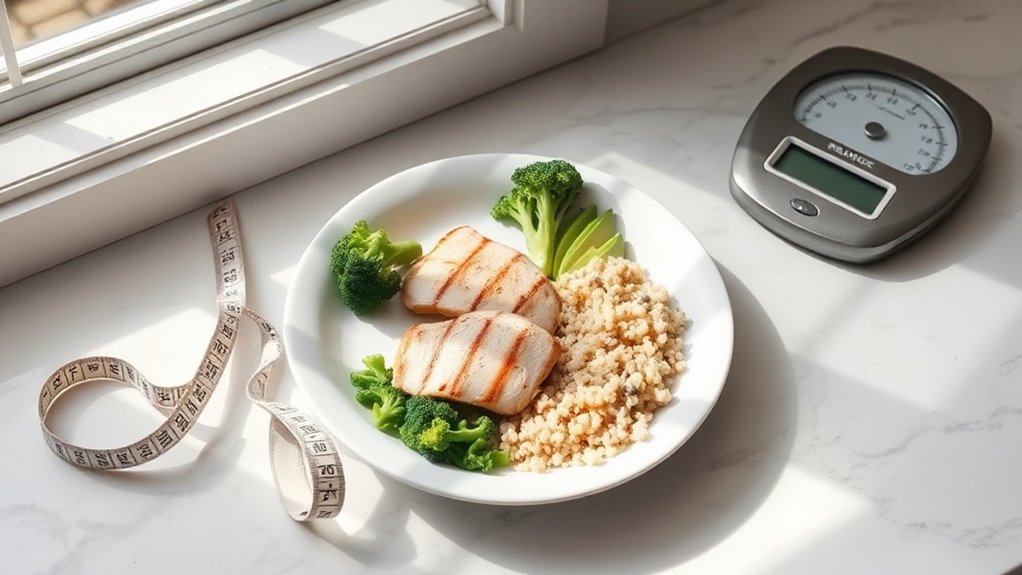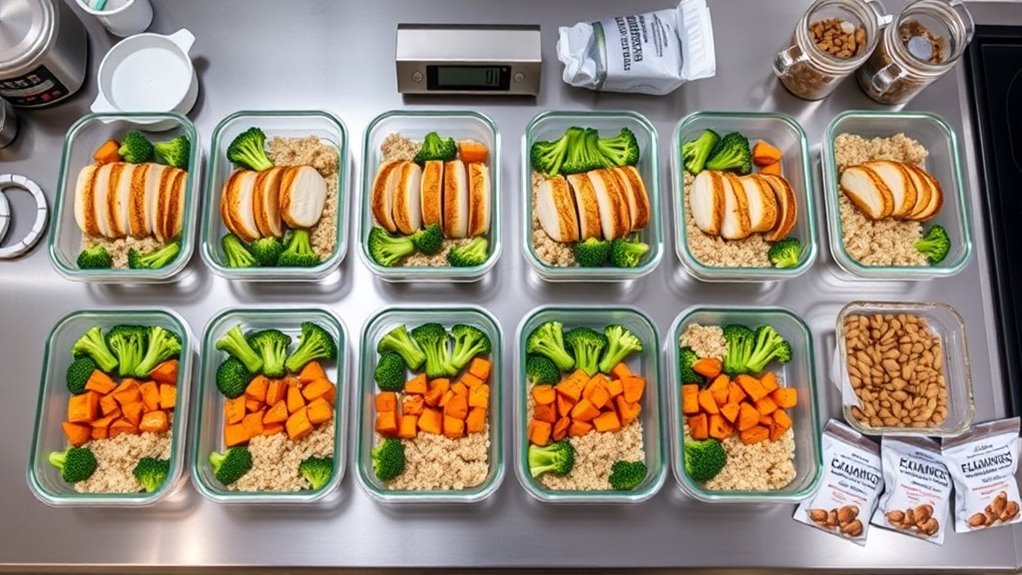Meal Planning Made Easy- Drop Pounds Without Starving
If you’re gently trimming your figure while staying satisfied, meal planning offers a smart path forward. You’ll build balanced plates with veggies, proteins, and grains to fuel your day, avoiding extremes that zap energy. Stick around to uncover simple strategies that keep you motivated and on track.
Key Takeaways
- Set realistic weight loss goals, aiming for 1-2 pounds weekly with simple, trackable meal plans.
- Select nutrient-rich foods like vegetables and fruits to promote fullness and curb hunger effectively.
- Build balanced meals with half veggies, quarter lean protein, and quarter whole grains for sustained energy.
- Create a precise grocery list and shop for fresh, seasonal items to streamline healthy meal prep.
- Prepare quick recipes, such as veggie stir-fries, using batch cooking to maintain motivation and control portions.
Set Realistic Weight Loss Goals
Setting realistic weight loss goals is the first step toward sustainable success in your meal planning journey.
You base these on your current health, aiming for 1-2 pounds weekly, as studies confirm this rate minimizes risks and boosts adherence.
Easy meal planning helps; you outline simple, flexible schedules that align with your routine, making tracking effortless.
Avoid extremes by setting measurable milestones, like weekly check-ins, to maintain motivation without overwhelm.
This balanced approach ensures you progress steadily, fostering long-term habits that support your goals.
To further enhance motivation, always celebrate small victories to keep your drive strong.
Choose Nutrient-Rich Foods for Satisfaction
How can you make your meals both satisfying and supportive of weight loss?
Start by selecting nutrient-rich foods like vegetables, fruits, whole grains, and lean proteins, which deliver essential vitamins, minerals, and fiber.
These options promote satiety through mechanisms such as fiber’s role in slowing digestion, as evidenced by studies showing reduced hunger hormones.
You’ll feel fuller with fewer calories, curbing cravings without deprivation.
For practicality, focus on variety—incorporate spinach for iron, berries for antioxidants, and nuts for healthy fats—to nourish your body effectively and sustain energy levels.
Balance ensures long-term success.
Additionally, enhance your strategy by incorporating high-fiber snacks before meals, such as carrots or cucumbers, to promote faster fullness and better appetite control.
Build Balanced Meals for Every Day
Building balanced meals daily helps you maintain steady energy and curb overeating, as research shows that combining carbs, proteins, and fats optimizes nutrient absorption and hormone regulation.
To create them, aim for meals that support your weight loss goals without extremes.
-
Balance your plate: Include half veggies for fiber, a quarter lean protein like chicken or beans for satiety, and a quarter whole grains for sustained energy, per dietary guidelines.
-
Watch portions: Use your hand to measure—palm-sized protein, fist-sized carbs—to prevent excess calories while feeling full.
-
Add healthy fats: Incorporate sources like avocados or nuts to enhance flavor and hormone balance, backed by nutrition studies.
Incorporate a protein-rich breakfast to further enhance metabolism and aid in reducing belly fat, as it promotes fullness and supports weight loss throughout the day.
Simplify Grocery Shopping Strategies
Efficient grocery shopping is key to sticking with your meal plan, so let’s explore strategies that cut down on time and temptation while keeping your choices nutritious.
Start by crafting a precise shopping list based on your weekly meals; research indicates this cuts impulse buys by 23%, per consumer studies.
Shop the store’s perimeter for fresh fruits, vegetables, and proteins, focusing on seasonal items for better nutrition and savings.
Use apps to compare prices and plan routes, saving you time.
Always eat before shopping to resist unhealthy temptations, ensuring your cart stays balanced and budget-friendly.
To enhance your meal prep, consider adding frozen fruits and veggies to your shopping list for convenient, nutritious options that save prep time.
Create Quick and Easy Recipes
You can incorporate quick recipe ideas into your meal plan to save time while keeping meals nutritious.
Focus on easy prep methods like using pre-chopped veggies or one-pan cooking to streamline your routine.
These healthy dish options balance flavors and nutrients, helping you stay on track with weight loss goals.
To maintain high energy, try adding protein-packed meals from your daily routine for better satiety and muscle support.
Quick Recipe Ideas
How can you streamline meal prep for weight loss without sacrificing nutrition?
By choosing quick recipes that emphasize whole foods, portion control, and balanced macros, you’ll fuel your body efficiently.
These ideas help maintain satiety while cutting calories, based on dietary guidelines from sources like the USDA.
-
Veggie Stir-Fry: Sauté broccoli, bell peppers, and tofu in minimal oil for a fiber-rich, 15-minute meal that supports muscle repair and curbs cravings.
-
Green Smoothie: Blend spinach, apple, Greek yogurt, and a dash of chia seeds for a vitamin-packed breakfast that boosts metabolism without added sugars.
-
Tuna Salad Wrap: Mix canned tuna with greens and avocado, wrap in lettuce for a protein-powered lunch that aids weight management through healthy fats.
Easy Prep Methods
While meal prep can feel overwhelming, adopting simple techniques like batch cooking and one-pan meals helps you craft nutritious recipes that align with weight loss goals, drawing from guidelines such as those from the USDA.
For instance, batch cooking lets you prepare large quantities of veggies and proteins ahead, reducing daily effort while controlling calories based on evidence from nutrition studies.
You’ll use active voice in your routine by chopping ingredients once for multiple meals, minimizing waste as per sustainable eating research.
One-pan methods simplify cleanup, making it easier to stick to balanced plans without excess fuss, promoting long-term adherence.
Healthy Dish Options
Exploring healthy dish options starts with quick recipes that blend nutrition and simplicity, drawing from USDA guidelines. You’ll balance macronutrients to support weight loss, using fresh ingredients that keep you satisfied and energized. These meals align with evidence-based recommendations for portion control and variety, making it easy to drop pounds without hunger.
- Grilled Chicken Salad: Grill lean chicken with mixed greens and veggies for a 15-minute meal packed with protein and fiber, per USDA’s MyPlate.
- Veggie Stir-Fry: Sauté colorful vegetables with tofu for a balanced dinner that delivers essential vitamins and controls calories effectively.
- Overnight Oats: Mix oats with fruits and nuts for a simple breakfast that provides sustained energy and aligns with fiber guidelines.
Master Portion Control Techniques
Why focus on portion control? It helps manage calorie intake without cutting out favorites, as studies like those from the National Institutes of Health show that larger servings lead to 20-30% more calories consumed unintentionally.
You’ll prevent overeating by using practical tools: divide your plate with half for veggies, a quarter for proteins, and a quarter for grains.
Measure with your hand—a fist for carbs, palm for proteins, thumb for fats—or use cups initially.
This balanced method promotes sustainable weight loss, keeping you full and nourished without extremes.
Additionally, incorporating the 10-second trick can help you pause before eating to better assess your hunger levels.
Maintain Energy and Motivation Daily
Maintaining energy and motivation daily is key to sticking with your weight loss plan, especially when meal prep feels routine.
You’ll sustain your efforts by combining nutrition, activity, and mindset, as research shows these elements reduce dropout rates.
Here’s how to keep going:
-
Fuel your body with balanced meals, including complex carbs and proteins, to maintain steady energy and prevent crashes.
-
Incorporate light exercise, like a daily walk, to boost endorphins and enhance your overall vitality.
-
Set small, realistic goals and track them, helping you stay motivated without overwhelming pressure.
To optimize your daily energy, remember to prioritize hydration as it plays a crucial role in combating fatigue and supporting overall vitality.

